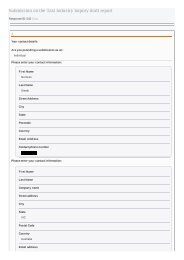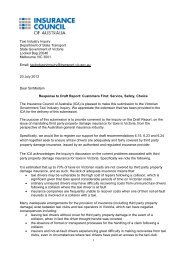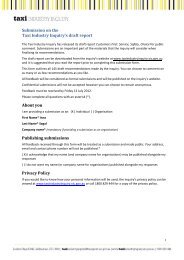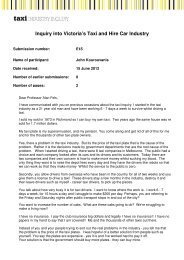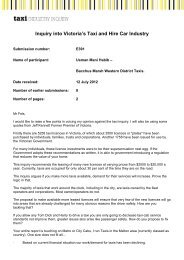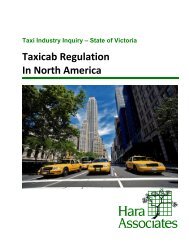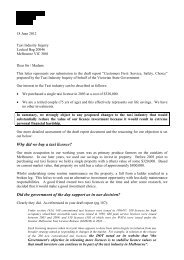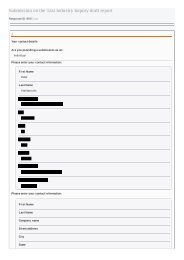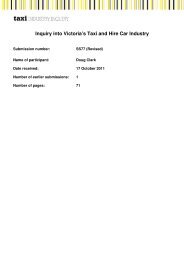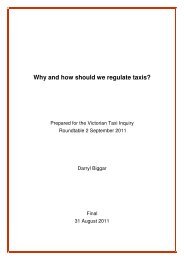Part D â Understanding and improving industry performance (PDF ...
Part D â Understanding and improving industry performance (PDF ...
Part D â Understanding and improving industry performance (PDF ...
Create successful ePaper yourself
Turn your PDF publications into a flip-book with our unique Google optimized e-Paper software.
• Licence liberalisation has generally produced positive<br />
effects for consumers in the form of improved<br />
availability of taxis, better service quality, reduced<br />
waiting times <strong>and</strong> a greater range of services offered.<br />
But it can be disruptive in the short term if it not<br />
delivered as part of a wider reform program.<br />
• Minimum quality controls are needed to reduce<br />
the potential negative impacts of liberalisation <strong>and</strong><br />
ensure adequate outcomes in the taxi <strong>industry</strong> postliberalisation.<br />
• The sequencing of reforms is important, with reform<br />
more likely to succeed where service <strong>and</strong> safety<br />
st<strong>and</strong>ards are established prior to relaxing entry<br />
requirements <strong>and</strong> where compliance with these<br />
st<strong>and</strong>ards is closely monitored post-liberalisation.<br />
• The choice of fare regime accompanying liberalisation<br />
is critical to ensuring that there is not an ‘oversupply’<br />
of taxis following liberalisation <strong>and</strong> that fares do not<br />
rise post-liberalisation.<br />
These issues are examined in greater detail throughout<br />
this chapter.<br />
9.2. Common approaches in<br />
other jurisdictions<br />
Alongside various degrees of restriction on entry, the<br />
inquiry’s examination of international jurisdictions reveals<br />
there are other common regulatory approaches used<br />
around the world. This section summarises these<br />
common approaches.<br />
9.2.1. Fare regulation<br />
Most places regulate taxi fares, even in open entry<br />
markets, albeit to different degrees. The rationale for<br />
regulating fares is that competition between taxis will<br />
not be effective while consumers face informational<br />
constraints <strong>and</strong> while certain market conventions act to<br />
limit competition – for example, the convention to take<br />
the first taxi off the rank.<br />
As noted throughout this report, in any discussion of<br />
taxi markets, it is important to underst<strong>and</strong> the difference<br />
between the rank <strong>and</strong> hail market <strong>and</strong> the pre-booked<br />
market for taxi services. The market failures mentioned<br />
above are evident predominantly in the rank <strong>and</strong> hail<br />
market. In the pre-booked market, consumers are usually<br />
better placed to ‘shop around’ to obtain the service they<br />
want at the ‘right’ price, making the rationale for fare<br />
regulation in the pre-booked market less compelling.<br />
There are several main forms of fare regulation found in<br />
international jurisdictions:<br />
• Regulated set fare schedule – where all components<br />
of a fare (flagfall, distance charge) are decided by<br />
government <strong>and</strong> service providers must charge<br />
according to the fare schedule. This is common in<br />
jurisdictions with restricted entry, such as New York.<br />
• Regulated maximum fare – where government sets<br />
a maximum fare amount <strong>and</strong> service providers are<br />
free to charge less than the maximum (sometimes<br />
a minimum fare is established in addition to a<br />
maximum). All Australian jurisdictions, other than<br />
Victoria, have maximum fares set by government,<br />
where the driver can charge any rate at or below the<br />
metered fare.<br />
• Fare notification – where <strong>industry</strong> participants (often<br />
taxi booking companies) are allowed to set their own<br />
fares, but must have the fare registered or approved<br />
with the taxi authority prior to it coming into force.<br />
For example, New Zeal<strong>and</strong> requires Authorised Taxi<br />
Organisations (ATOs) to register maximum fares with<br />
the New Zeal<strong>and</strong> Transport Agency (NZTA) <strong>and</strong> have<br />
these fares approved prior to coming into effect.<br />
• Facilitated price comparisons, such as fare posting<br />
requirements – where service providers are free to<br />
choose the fares they charge; however, fares must<br />
be advertised or ‘posted’ on each taxi in a prescribed<br />
manner. In addition, some jurisdictions require fares<br />
to be pre-registered with the regulator. For example,<br />
while fares are deregulated in Sweden, there are<br />
guidelines <strong>and</strong> agreements for how fares should be<br />
displayed both inside <strong>and</strong> outside the taxi.<br />
The following components of taxi fares are often (but not<br />
always) regulated:<br />
• Flagfall<br />
• Amount charged per unit of distance<br />
• Amount charged per unit of wait time (applies if<br />
vehicle speed falls below a set speed)<br />
• Booking fee<br />
• Late night <strong>and</strong> holiday fees<br />
• Fees depending on number of passengers, zone<br />
or area of operation.<br />
A more detailed discussion on fare regulation <strong>and</strong> fare<br />
structures, including approaches taken in different<br />
jurisdictions, is included in chapter 20.<br />
160




